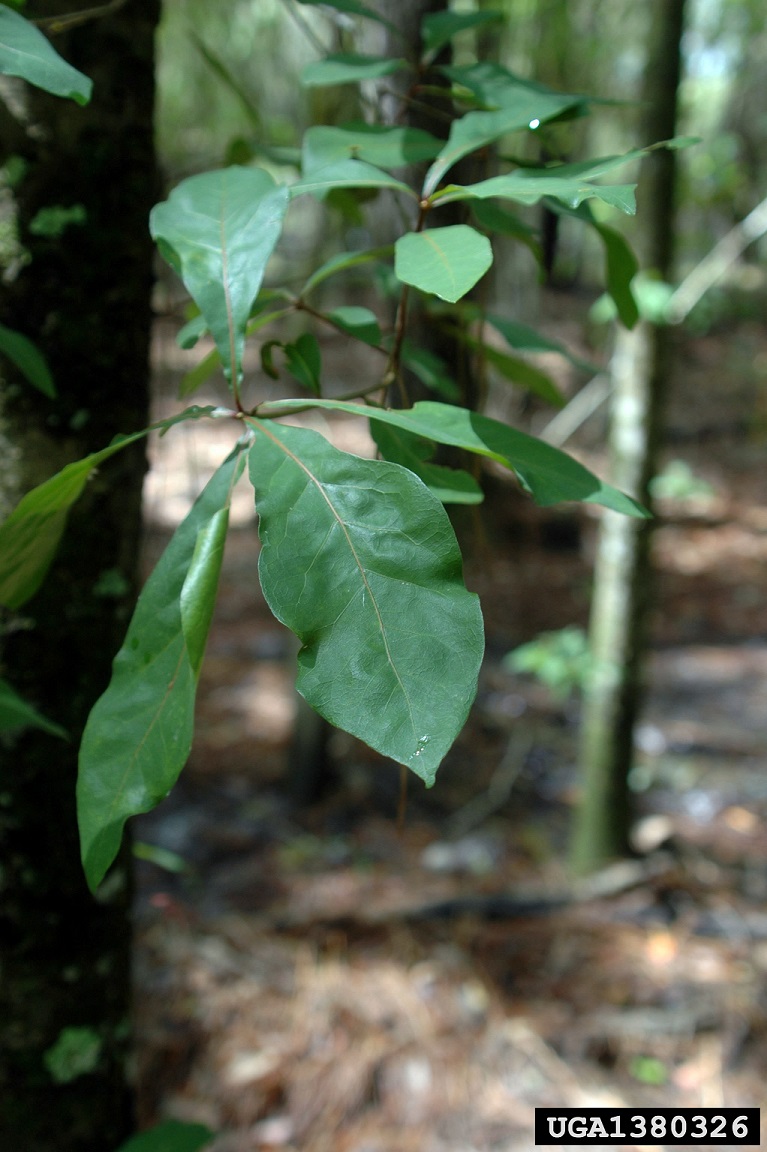Quercus laurifolia
| Quercus laurifolia | |
|---|---|

| |
| Photo by Chris Evans, University of Illinois, Bugwood.org | |
| Scientific classification | |
| Kingdom: | Plantae |
| Division: | Magnoliophyta - Flowering plants |
| Class: | Magnoliopsida – Dicotyledons |
| Order: | Fagales |
| Family: | Fagaceae |
| Genus: | Quercus |
| Species: | Q. laurifolia |
| Binomial name | |
| Quercus laurifolia Michx. | |

| |
| Natural range of Quercus laurifolia from USDA NRCS Plants Database. | |
Common names: Laurel oak, Swamp laurel oak, Diamond oak
Contents
Taxonomic notes
Synonym: Quercus obtusa (Willdenow) Ashe
Description
A description of Quercus laurifolia is provided in The Flora of North America.
Distribution
Ecology
Habitat
Q. laurifolia has been found in longleaf pine-turkey oak sand ridges, sand pine scrub, salt marsh shorelines, sand dunes, areas with sandy-peaty soil, live oak groves, pond shorelines, pine flatwoods, and scrub oak.[1] It is also found in disturbed areas including disturbed oak pine Ilex woods, near boat landings, and along roadsides.[2][3][4]
Associated species: Q. geminata, Q. chapmanii, Q. laevis, Pinus clausa, Ceratiola ericoides, Osmanthus, Q. virginiana, Q. nigra , and Q. myrtifolia.[1]
Phenology
Q. laurifolia has been observed to flower from March to May, and in August and September.[5]
Seed dispersal
This species is thought to be dispersed by gravity.[6]
Herbivory and toxicology
Quercus laurifolia has been observed at the Archbold Biological Station to host bees such as Apis mellifera (family Apidae) and Colletes brimleyi (family Colletidae).[7] Additionally, this species has been observed to host planthoppers such as Alebra sp. (family Cicadellidae) and members of the Flatidae family such as Metcalfa pruinosa and Ormenoides venusta, true bugs such as Cedusa sp. (family Derbidae), and treehoppers from the Membracidae family such as Archasia belfragei, Cyrtolobus fuliginosus, Cyrtolobus ovatus, Cyrtolobus tuberosus, Ophiderma definita, Ophiderma pubescens, and Smilia camelus.[8] Q. laurifolia frequently produces large crops of acorns that are an important food source for raccoons, white-tailed deer, squirrels, wild turkeys, ducks, quail, and smaller birds and rodents.[9].
Conservation, cultivation, and restoration
Cultural use
Bark was mixed with other oak species bark by the Choctaw to create dyes and paints.[10]
Photo Gallery
References and notes
- ↑ 1.0 1.1 Florida State University Herbarium Database. URL: http://herbarium.bio.fsu.edu. Last accessed: June 2021. Collectors: L. J. Brass, William B. Fox, Robert K. Godfrey, Robert Kral, O. Lakela, Robert L. Lazor, Sidney McDaniel, and W. D. Rees. States and counties: Florida: Bay, Citrus, Collier, Franklin, Hernando, Leon, Levy, Madison, Martin, Putnam.
- ↑ Eastern Kentucky University, Ronald L. Jones Herbarium accessed using Southeastern Regional Network of Expertise and Collections (SERNEC) data portal. URL: http://sernecportal.org/portal/collections/index.php Last accessed: June 2021. Collectors: Timothy J. Weckman. States and Counties: Florida: Walton.
- ↑ Emory University Herbarium accessed using Southeastern Regional Network of Expertise and Collections (SERNEC) data portal. URL: http://sernecportal.org/portal/collections/index.php Last accessed: June 2021. Collectors: Don E. Eyles. States and Counties: Georgia: Clinch.
- ↑ Highlands Biological Station Herbarium accessed using Southeastern Regional Network of Expertise and Collections (SERNEC) data portal. URL: http://sernecportal.org/portal/collections/index.php Last accessed: June 2021. Collectors: Michael Cable. States and Counties: South Carolina: Beaufort.
- ↑ Nelson, G. PanFlora: Plant data for the eastern United States with emphasis on the Southeastern Coastal Plains, Florida, and the Florida Panhandle. www.gilnelson.com/PanFlora/ Accessed: 13 DEC 2016
- ↑ Kirkman, L. Katherine. Unpublished database of seed dispersal mode of plants found in Coastal Plain longleaf pine-grasslands of the Jones Ecological Research Center, Georgia.
- ↑ Deyrup, M.A. and N.D. 2015. Database of observations of Hymenoptera visitations to flowers of plants on Archbold Biological Station, Florida, USA.
- ↑ Discoverlife.org [1]
- ↑ Robert D. McReynolds, E. A. Hebb. 1990. Silvics of North America: Hardwoods. US Department of Agriculture, Forest Service.
- ↑ Austin D. 2004 Oaks Discovering Florida's Ethnobotany with Dr. Dan Austin Palmetto 22(4):12-17